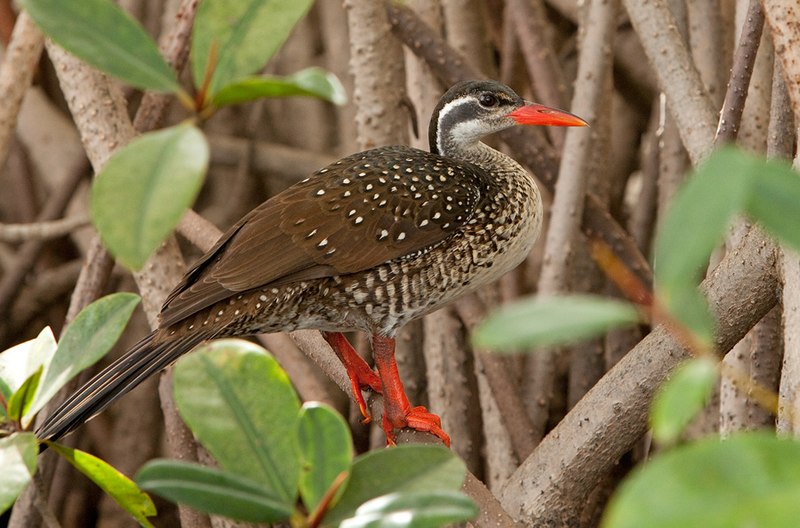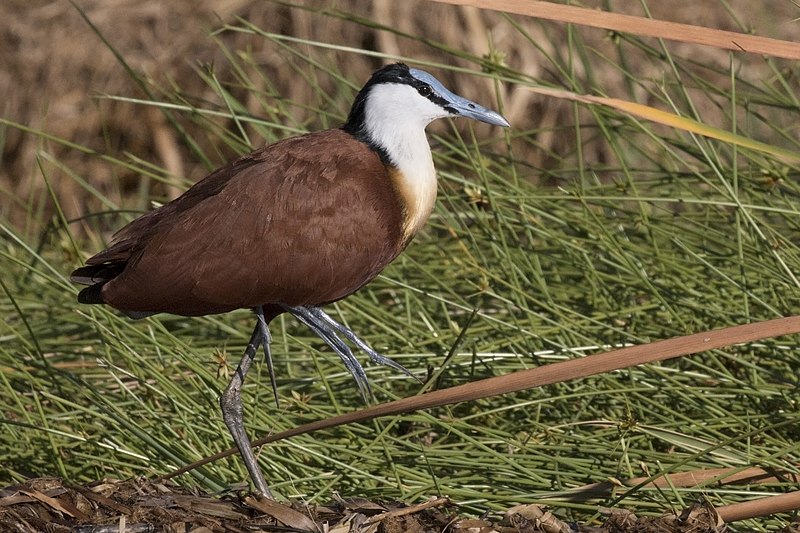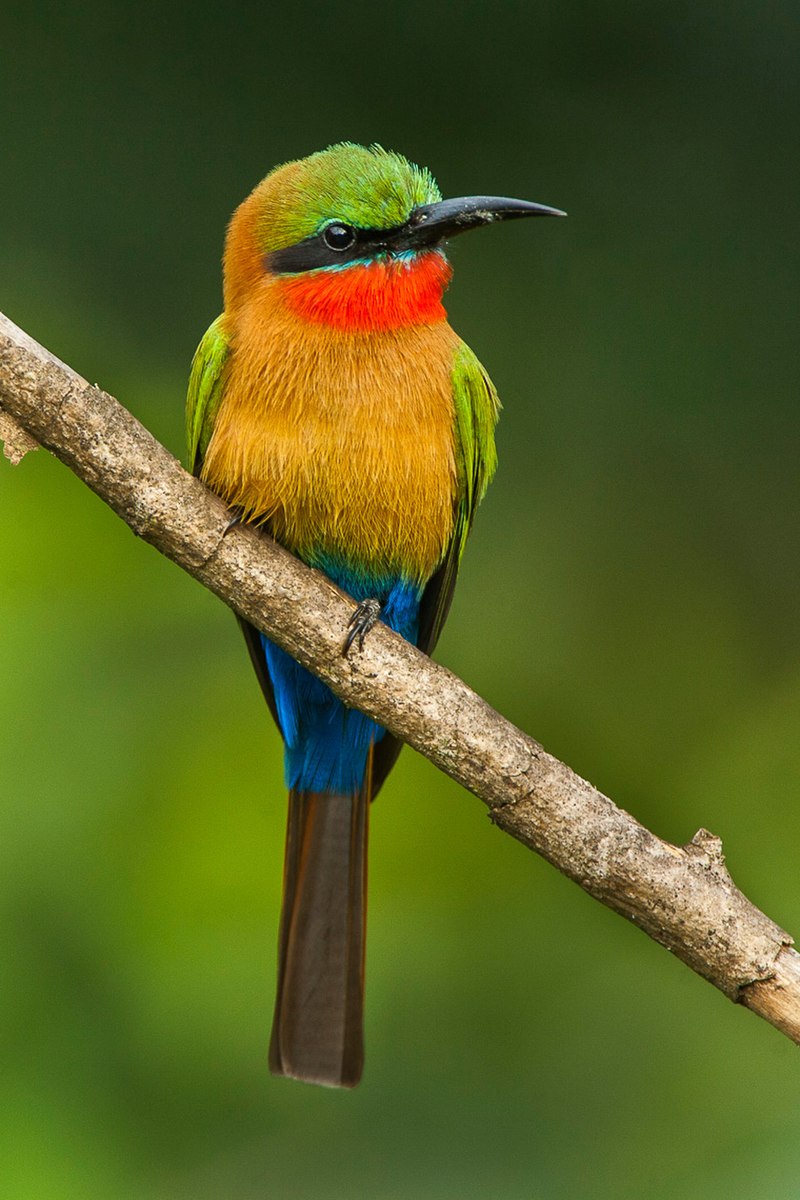Cote d’Ivoire, or the Ivory Coast, is home to various bird species, ranging from the brightly-coloured bee-eaters and guineafowls to the more elusive species such as the elusive nightjars and the endemic Malimbes.
With its diverse and vibrant birdlife, Cote d’Ivoire is one of the most popular bird-watching destinations in West Africa.
From the lush rainforests of the Comoe National Park to the savannahs of the Marahoue National Park, birders of all levels of experience can find something to appreciate in this beautiful country.
6 Cote D’Ivoire (Ivory Coast) Birds
Cote d’Ivoire, also known as Ivory Coast, is a country in West Africa with a rich diversity of bird species. Here are six birds that can be found in Cote d’Ivoire:
1. Heliornithidae

Heliornithidae, commonly known as finfoots, are a small family of tropical birds found in South America and Africa. They have webbed feet like grebes or coots, long necks, slender bodies and broad tails with sharp, pointed bills.
Their diverse calls include whistles, squawks and croaks, which they use to communicate with each other.
Finfoots feed mainly on fish but also consume insects such as water beetles and dragonflies near the surface of water bodies.
They nest around rivers or lakes with plenty of cover from predators such as eagles or hawks.
During the breeding season, males can become quite territorial, defending their territories against intruders by chasing them off aggressively using loud noises or even physical contact if necessary.
Scientific classification:
| Kingdom | Animalia |
| Phylum | Chordata |
| Class | Aves |
| Order | Gruiformes |
| Family | Heliornithidae GR Gray, 1840 |
2. African Jacana

The African Jacana is a charming wader belonging to the family of Jacanidae, mostly found in sub-Saharan Africa.
It has long toes and claws that allow it to walk on floating vegetation in shallow lakes, which form its preferred habitat.
The bird was officially described by Johann Friedri in 1789 with an interesting origin and pronunciation for its name -Jacanidae.
This aquatic bird is known for its striking plumage features like yellow crowns and black wings marked with chestnut brown stripes across them, making them look even more attractive when they spread their wing feathers during courtship displays.
They feed mainly on insects, tadpoles, frogs, etc., skimming nearby water surfaces or plucking prey from vegetation as they wander around these wetlands areas.
Scientific classification:
| Kingdom | Animalia |
| Phylum | Chordata |
| Class | Aves |
| Order | Charadriiformes |
| Family | Jacanidae |
| Genus | Actophilornis |
| Species | A. africanus |
3. Red-Throated Bee-Eater

The Red-throated Bee-eater is a beautiful species of bird found in tropical Africa. It has bright red feathers covering its throat, giving it a distinct look. Its body is mostly brown with white stripes, and its wings are dark blue on the tips.
This species enjoys an extensive range throughout countries like Benin, Burkina Faso, and Togo, to name just a few.
These birds feed mainly on insects that they catch in midair or from nearby foliage during their hunting flights over open country habitats such as woodlands and savannas.
While not much else is known about this particular type of bee-eater, these colourful creatures have surely become quite popular due to their striking beauty.
Scientific classification:
| Kingdom | Animalia |
| Phylum | Chordata |
| Class | Aves |
| Order | Coraciiformes |
| Family | Meropidae |
| Genus | Merops |
| Species | M. bulocki |
4. Yellow-Casqued Hornbill
The Yellow-casqued Hornbill is an impressive bird found in the rainforests of West Africa. It has a bright yellow casque on its head and weighs up to 2kg, making it one of the largest birds in its region.
Its primary habitat is in the canopy, where it feeds mostly on fruits, insects and small animals like lizards or frogs.
They are known for their loud calls, which can be heard from far away during mating season when pairs join together to nest near tree hollows or cavities built by other species.
A monogamous pair stays together throughout the breeding season, with both parents taking turns incubating eggs and feeding chicks until they can fly off into independence day.
These unique creatures have adapted well to their environment since ancient times, but habitat destruction and human hunting activity threaten this species greatly today, forcing conservationists across continents to fight for their protection through policy change and public awareness campaigns.
Scientific classification:
| Kingdom | Animalia |
| Phylum | Chordata |
| Class | Aves |
| Order | Bucerotiformes |
| Family | Bucerotidae |
| Genus | Ceratogymna |
| Species | C. elata |
5. Brown-Cheeked Hornbill
The Brown-Cheeked Hornbill is a species of bird from the Bucerotidae family, native to West Africa and found in countries such as Ivory Coast, Ghana, Guinea, Liberia and Sierra Leone.
It prefers to inhabit tropical or subtropical moist forests and plantations with secondary growths. Unfortunately, its populations are declining due to habitat destruction caused by human activities such as timber harvesting.
This beautiful bird has brown feathers on its body, while its head feathers are black with yellow stripes running down either side at the top of its head towards the eyes, with blue skin around them.
The males also feature an orange bill, while females lack this trait completely, instead having a dark grey one.
Despite being threatened, they remain quite common across their range. However, conservation efforts must be undertaken if we wish for these birds to continue living happily for many more years.
Scientific classification:
| Kingdom | Animalia |
| Phylum | Chordata |
| Class | Aves |
| Order | Bucerotiformes |
| Family | Bucerotidae |
| Genus | Bycanistes |
| Species | B. cylindricus |
6. Forest Wood Hoopoe
The Forest wood hoopoe is a species of bird belonging to the family Phoeniculidae, native to parts of Central and West Africa.
It has a black head with an orange-brown crest on top, white throat, yellow breast barred wings and tail feathers.
This medium-sized bird measures around 25 cm in length from its beak tip to the end of its tail. Its diet consists mainly of insects such as ants and termites; it may also feed on small lizards or fruits occasionally.
The male sings melodiously during mating season while displaying his brightly coloured plumage, which serves as camouflage against predators and an attractive display for potential mates.
Habitat loss due to deforestation remains one of the biggest threats facing this species today, but conservation efforts are underway in many countries across their range to protect these birds from extinction by creating protected areas where they can breed safely without fear of disturbance or destruction
.Scientific classification:
| Kingdom | Animalia |
| Phylum | Chordata |
| Class | Aves |
| Order | Bucerotiformes |
| Family | Phoeniculidae |
| Genus | Phoeniculus |
| Species | P. castaneiceps |
To Recap
Our field observations and genetic analyses of six bird species in Cote d’Ivoire have provided valuable insights into their ecology and behaviour.
We have gained a deeper understanding of their habitat preferences, foraging strategies, and breeding habits, which are essential for their conservation and management.
Additionally, genetic analyses have shed light on their population structure and potential genetic diversity, offering crucial information for future conservation efforts.
These findings emphasize the importance of preserving the diverse ecosystems in Cote d’Ivoire to safeguard these bird species and contribute to the broader understanding of avian biodiversity in the region.
Further research and conservation initiatives are warranted to protect these birds and their habitats.